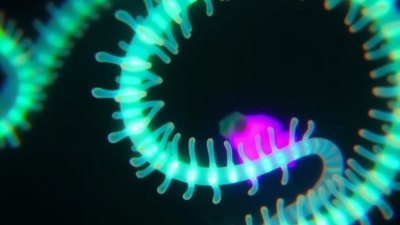Learning to Identify Local Bioluminescent Organisms on Night Dives
Discover how to identify bioluminescent organisms during night dives for a memorable underwater experience.

Image created with Flux Schnell
Venturing into the underwater realm at night provides a unique and awe-inspiring experience, especially when bioluminescent organisms illuminate the dark depths. These living lights offer a glimpse into one of nature's most fascinating phenomena. This article aims to guide divers in learning how to identify local bioluminescent organisms during night dives, enhancing your underwater adventure significantly.
Understanding Bioluminescence
Bioluminescence is the production and emission of light by living organisms, and it occurs widely in marine environments. While certain land organisms, like fireflies, also exhibit bioluminescence, the ocean hosts a plethora of species that utilize this phenomenon for various purposes, such as attracting prey, communication, or camouflage. Knowing what bioluminescent organisms are present in your diving area will enhance your night dive and create memorable experiences.
The Science Behind Bioluminescence
Bioluminescence occurs through a chemical reaction within an organism that involves a light-emitting pigment called luciferin and an enzyme known as luciferase. When oxygen is present, luciferin is oxidized, resulting in the release of light. This fascinating process is common in various marine organisms, including plankton, jellyfish, and certain fish species.
Familiarizing with Local Bioluminescent Species
Understanding which bioluminescent organisms you might encounter on your night dives is crucial. Here are some common marine bioluminescent organisms to look for:
1. Dinoflagellates
Dinoflagellates are single-celled organisms often responsible for the blue glow seen in many coastal regions. When disturbed, they emit bright flashes of light, creating stunning displays in the water. Observing these tiny organisms during your dive can be magical, especially during moments of movement.
2. Jellyfish
Many species of jellyfish exhibit bioluminescence. The light produced can be blue or green, visible during the dark night. The captivating glow acts as a defense mechanism to confuse predators and attracts prey. Look for jellyfish gliding gracefully through the water, leaving trails of light behind.
3. Lanternfish
Known as one of the most abundant fish species in the ocean, lanternfish possess light-emitting organs along their bodies. These lights can help attract prey and communicate with fellow lanternfish. Spotting them during a night dive adds an exciting dimension to your experience.
4. Certain Types of Shrimp
Some shrimp, like the mantis shrimp, have bioluminescent properties. They can produce flashes of light to communicate or ward off predators. Observing the behavior of these remarkable creatures can give you insight into their intriguing lives.
5. Coral
Corals can also display bioluminescence, particularly certain species under specific conditions (e.g., stress or predation). While typically not as vivid as other organisms, witnessing corals glowing in the dark can enhance the marine environment's beauty.
Preparation for Night Dives
To ensure a safe and successful night diving experience focused on bioluminescent organisms, proper preparation is vital:
1. Choose the Right Location
Research dive sites in advance to find locations known for bioluminescent activity. Coastal regions during warmer months often yield the best results.
2. Gear Up Appropriately
Ensure you have the right gear for night diving, including a reliable dive light. Consider underwater cameras with good low-light capabilities if you wish to capture the magical moment of bioluminescent displays.
3. Dive with a Buddy
Always dive with a buddy, especially at night. This ensures safety and enhances the experience as you both can share your findings and observations.
4. Maintain Safety Protocols
Familiarize yourself with the dive site, ensure proper communication methods with your buddy, and follow all safety protocols. Night diving requires heightened awareness and precaution.
Identifying Bioluminescent Organisms
During your dive, it’s essential to know how to identify these glowing organisms:
1. Look for Movement
Most bioluminescent organisms are stirred by waves or movement. Be attentive to disturbances in the water that may trigger light displays.
2. Observe the Colors
Pay attention to the colors exhibited by the organisms. Different species may emit different hues, typically blues and greens. Familiarize yourself with the characteristics of local species to identify them easily.
3. Use Your Dive Light Wisely
Use your dive light sparingly! A bright light may scare away some bioluminescent organisms. Instead, use it to guide yourself while allowing your eyes to adjust to the dark or to reveal more about the organisms.
Recording Your Experiences
Taking notes or recording your sightings can elevate your diving experience. Keeping a dive log can help you track which organisms you've encountered.
Ethical Interaction with Bioluminescent Organisms
While observing bioluminescent organisms, it's crucial to approach them ethically:
1. Minimal Touch
Avoid touching or disturbing marine life, as this can harm both the organisms and the delicate ecosystems they inhabit.
2. Preserve the Environment
Be mindful of your behavior—consider not using bright lights that can disrupt marine life or stir them into unnecessary motion. Preserve the underwater environment.
3. Spread Awareness
Educate fellow divers about the importance of bioluminescent organisms. Advocating for their conservation ensures future generations can enjoy similar experiences.
Identifying local bioluminescent organisms during night dives not only enhances your appreciation for marine ecosystems but also contributes to ongoing conservation efforts. By knowing what to look for, embracing safety practices, and interacting ethically, divers can delve into an enchanting underwater world illuminated by these natural wonders. Next time you embark on a night dive, be prepared to witness one of nature’s most breathtaking displays and to cultivate a deeper connection with the marine life that calls our oceans home.











